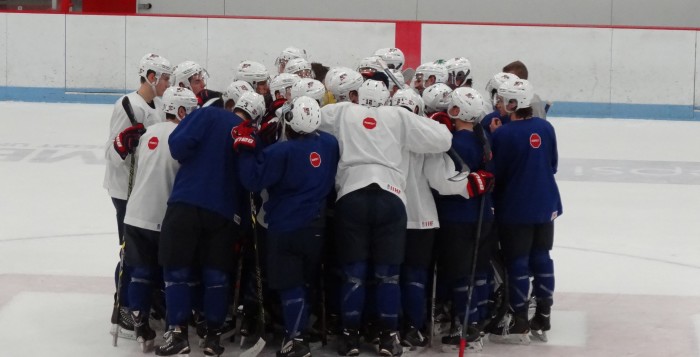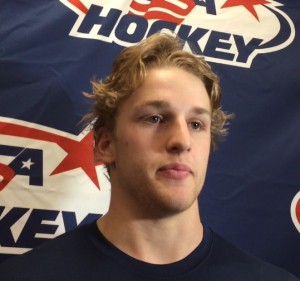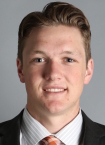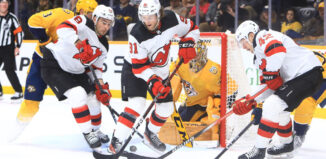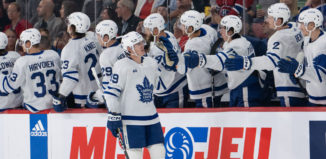USA Team Camp Fosters Family
Sitting in Walter Brown Arena, watching the rink come to life for another day of the U.S. National Junior Team camp offers a peek at a world that many hockey fans do not see. The silence offers players, coaches and rink rats that opportunity to pause and contemplate the upcoming day.
And despite the fact that every arena looks relatively the same, it is often the place that you will find solitary players soaking in the atmosphere, even if just for a minute. They will sit on the bench, beanies on heads that are happier wearing helmets, perhaps with headphones in their ears. Eyes scan the ice, perhaps picturing plays in holographic form invisible to the rest of us. Some lean casually against the boards, chatting, drinking their morning beverage of choice, but all as though their day isn’t real if they aren’t doing these things in the rink.
This is the Norman Rockwell painting of the passion that lives inside each hockey player. This need and yearning to absorb this essence from the rink and the ice that is almost as essential to the existence of the hockey player as food and water are to the average person.
This is the picture that shows the longing, drive and determination that has brought these young players to this point in their development. It is a milestone in what will prove to be amazing careers for many of these teenagers as they continue their climb to “The Show;” careers that will be filled with many milestones.
It is also here as the rink comes to life that the observant, and early arrivals, can see the camaraderies playing out among the players as they drift out to the bench—as though being pulled by an unseen tether. The shoulder bumps, hugs from behind to the unsuspecting, and the general togetherness of the players speak to associations past and present.
Unlike the days of old when Herb Brooks struggled to get his group of college kids to put aside their school rivalries and think of themselves as a single unit with his Miracle Team, today’s elite young players have much more interaction with each other. Some of them have grown up together. Others were introduced as they went through USA Hockey’s National Team Development Program. Many played together or against each other on the various USHL teams that kept them eligible for colleges.
Even of those players, like Miles Wood who knew only one on the team, they have been welcomed and the returning players have seen it as their responsibility to help the first year players.
“Try to bring some calmness to the locker room. Just keep it a little bit lighter,”Minnesota Gopher, and returning forward, Hudson Fasching told The Pink Puck. “The tournament’s pretty heavy. It’s intense, so just keep it light in the locker room.”
And like all families, there is kidding among the players sometimes in where they come from and where they are playing now.
“[Ian] McCoshen is kind of an iffy Minnesota guy, half and half,” Fasching joked on the last day of camp as the number of players representing Minnesota was discussed. “I’m not rejecting him as a Minnesota guy, I’m just saying ….”
McCoshen was born in California and grew up in Wisconsin. When he went to Shattuck-St. Mary’s, his parents moved to Minnesota. Now McCoshen plays for the Boston College Eagles. So this is apparently how he becomes half a Minnesota guy.
It was all in good fun and it showed that the players really are comfortable with each other. Regardless of where they come from, when they put on the USA jersey, it is all about playing for the Red, White and Blue.
And Thatcher Demko who got to see Jack Eichel up close when the Boston College-Boston University game was televised, admitted to messing with Eichel with his glove.
“Oh absolutely,” Demko grinned. “I was kind of baiting him a little bit.”
And now they are on the same team.
Demko, who will be sitting out against the Boston University Terriers during Friday night’s game, said that he feels a little more comfortable having Eichel on his team.
“He’s obviously a threat offensively, so when he’s on the ice , when he’s against you, you always have to be aware,” Demko said. “The hair on the back of your neck kind of sticks up a little bit. But when he’s on your team, you know you always have a chance to score.”
But Demko appreciates when Eichel is playing against him, as he feels it makes him a better goalie.
The word “family” is often thrown around in hockey, but during this quiet time before the pucks drop, the whistles blow and the drills begin, when the players haven’t put on their “game faces” or their “press faces” you see the true players. In the arena you really do see a family. While they have only been together for a few days as a team, and some will be going home, they are supportive and joking. They are brothers. They are family.

